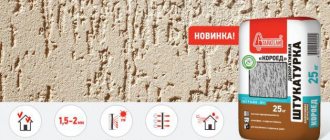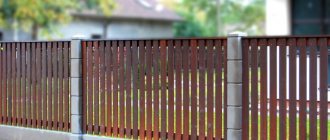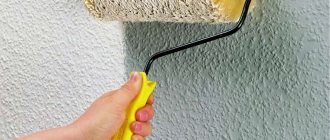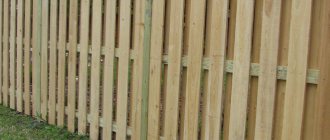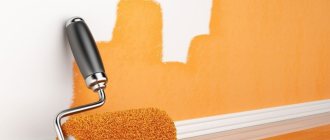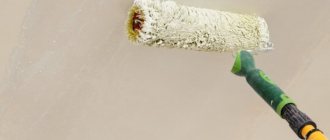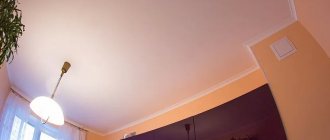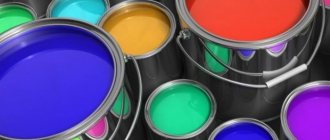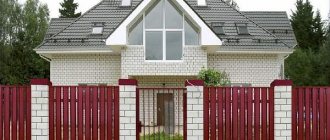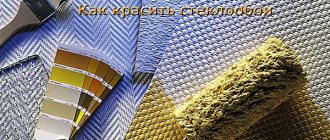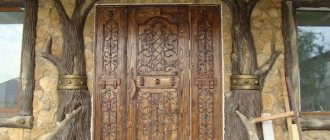Tip of the day admin2021
Before painting, the metal surface should be primed. For this purpose, GF-021 or similar ones are most often used. Its color is gray and red-brown. To reduce the amount of paint used, a more suitable primer is selected. It is applied to a dry, clean surface with a brush, roller or using a spray gun in 1-2 layers. After the primer has dried, begin painting. To prevent the primer from showing through, the paint will have to be applied in two layers.
How to install and paint metal fence posts A neat, well-kept fence with an interesting design enclosing a country cottage or dacha not only gives a feeling of security, but also provides a beautiful appearance to the home. Whatever fence material you choose, it will need support in the form of pillars. The most popular option for such supports are metal poles. The popularity of metal poles is explained by their affordable price, durability, long service life, ease of installation and the ability to combine with other building materials.
What types of metal poles are there?
Pipes with the following types of sections are usually used as metal fence supports: Pipes with a round cross-section have a low cost.
The height of this type of pipe varies from two and a half to four meters, and the diameter ranges from 57 to 108 millimeters. Pipes with a square cross-section are easier to install, and due to the presence of stiffeners, they are more reliable. For them, you do not need to purchase plates that act as a stabilizer. The wall thickness of such pipes is 2–4 mm.
Pipes with a rectangular cross-section have the same properties as pipes with a square cross-section; they differ only in their design.
In the production of metal poles, the method of internal and external hot-dip galvanizing can be used, which increases the service life of these products. The thickness of galvanizing is usually 135 microns. The thickness of the polymer coating most often ranges from 65 to 90 microns.
The strongest and most durable are metal poles, which simultaneously have a zinc and polymer coating. For waterproofing, metal caps are attached to metal pipes. The cost of metal poles directly depends on its quality and service life of the product and is calculated per linear meter.
Choosing a mounting method
In order for the fence to be of high quality and durable, it is necessary to take into account the freezing depth and soil type when installing it.
If the soil on which the fence is installed is sandy and light, then the posts can be installed using the screwing or driving method. The driving method is very simple and involves hammering the post into the hole with a sledgehammer. At the same time, the main thing is not to forget to control the evenness of the installation using a building level. The screwing method is more complicated. To do this, you need to weld one or two screws to the end of the pipe and screw it into the hole. It is better to take a round and thin pipe. When using this installation method, you must definitely think about how the supports will be dismantled.
If the soil is marshy, then to install metal pillars you will have to make a strip-type foundation, which also needs to be strengthened, and the pillars themselves must be protected as thoroughly as possible from possible corrosion.
In the case of heaving soil, it is necessary to use the butting or partial cementing method. Attention! The installation depth of the supports should be at least one third of the height of the fence and be no higher than 20 cm from the frost line. If the fence has a height of 2.5 meters, then the depth of digging of the support posts should be half its height! Let's consider the process of installing metal supports using the example of a fence installed on heaving soil. Before installing the supports, measure the area and draw up a plan for the location of the fence with an indication on it the obtained data, as well as the places where the gates, wicket, support pillars, etc. will be located. Then the perimeter is marked using wooden pegs and twine. First you need to install pegs in the corners of the future fence, then in those places where the gate and gate will be located, after which the location of the intermediate supports is noted. The distance between supports should be no more than 2.5 meters.
If the distance is made greater, the fence will sag and lose its resistance to the wind. If you want your fence to be not only strong and durable, but also beautiful, then the distance between all posts should be equal.
Where the greatest load will be placed on the poles, for example, at the location where the wicket and gate are installed, it is worth using the most durable type of pipe. When everything necessary for installation has been prepared, you can proceed directly to the installation. The first step is to install the corner supports. To do this, holes are dug with a diameter of no more than 40 cm. Sand mixed with stones is poured into the bottom of this hole in a layer about 5 cm thick.
Below is located. dedicated to preparing holes for metal supports: Next, install a post in the hole and level it using a building level. The post is secured using the butting method.
This method consists of doing the following: In the hole in which the support will be installed, crushed stone is poured on top of the sand-stone mixture (a layer of 15-20 cm), compacted tightly and watered with water. Then another layer of crushed stone is poured and again it is compacted and watered. In this way, layers are poured until 15–20 cm remains to the soil surface. After filling each layer, it is imperative to check whether the pillar has tilted. The remaining centimeters to the surface are filled with concrete.
On heaving soil, they use butting because crushed stone easily allows groundwater to pass through it, which moves during periodic freezing and thawing, while water cannot penetrate through cement and, as a result, pushes it out. The next step is to install supports for fastening wickets and gates. As already mentioned, these supports will be subject to quite a heavy load, so you should choose the strongest possible pillars. Also, in order for these supports to stand as securely as possible, they can be dug deeper than the others.
When the corner supports and supports for attaching the wicket and gate are installed, you can begin installing the intermediate metal posts. When installing metal support posts, it is worth constantly monitoring their height, linearity and alignment.
If the installation of the supports is carried out efficiently, the fence will delight you with its beauty and reliability for several decades. You can familiarize yourself with more detailed instructions for installing metal support posts by watching the following video:
The need for coloring
Owners of old corrugated roofs, after the service life of this practical material has expired, often wonder whether it is possible to use painting to restore the structure to its original appearance and resistance to moisture. During use, profiled steel sheets become covered with scratches, chips and abrasions, which become the cause of corrosion. Coloring of corrugated sheets is used in the following situations:
- Scratches and chips, deep damage that appears on the material due to careless transportation or improper storage even before installation, can be eliminated with your own hands using specially selected paint.
- If cheap galvanized corrugated sheets without a protective coating were used for the roofing, its performance characteristics can be improved by painting.
- High-quality painting extends the life of structures that have served for 10-15 years.
- With the help of a fresh paint coating, you can update the appearance of the corrugated sheet or change the color of the structure.
Note! Manufacturers of profiled sheets do not deny that during operation, the coloring pigment is destroyed by ultraviolet radiation, the color fades, and the paint fades. The difficulty lies in the fact that even during production, a paint or polymer coating is applied to this material even before the profile is extruded.
Painting metal supports
The lower part of the pillar, which will be in the ground, is covered with bitumen mastic.
The poles can be painted both before and after installation. If you decide to paint the poles before installation, then remember that during the installation process the coating may be damaged, and it is easier to paint on all sides in a vertical position. The painting process occurs in several stages:
- Preparation of the surface to be painted: removal of dirt, dust, old coatings.
- Removing rust using special tools and sandpaper or an abrasive brush.
- Applying primer.
- Painting in two layers.
Currently, three-in-one paints have appeared.
They can be applied even to an unprepared surface without removing rust. But reviews from people who have used such paints are not always positive. It often happens that this type of coating is of poor quality, and its cost is quite high. Therefore, it is better to trust proven materials and painting methods. You need to use paint that is intended for coating metal products and outdoor use.
Acrylic paint for metal
Types of paints for painting corrugated sheets
To change the shade of a metal profile, to refresh the protective coating or to hide minor defects on the surface, you can use various paints for corrugated sheets that can withstand rapid temperature changes, do not lose brightness when exposed to direct sunlight, and protect the roof from water. Correctly selected paint for a metal roof will determine how high-quality the roofing will be and how long it will last.
Before you paint corrugated sheets with your own hands, you need to understand the types of compositions:
- Epoxy polyester, polyester and alkyd enamel . Such enamels withstand a wide range of temperatures, excessive humidity and other weather conditions. However, over time, they lose elasticity, and defects appear on the surface in the form of a network of tiny cracks, which impair the protective qualities of the material. In addition, alkyd and polyester enamels cannot be used to paint galvanized products, since they are intended only for surface-treated metals.
- Acrylic paint . How to install roller shutters with your own hands? This is a water-dispersed paint, which is often purchased for coating profiled steel; it can be used to create different colors of metal profiles. The main positive quality of this paint composition is its high adhesive ability, which allows the coating to ideally lie on a metal base. This paint can be used to coat galvanized corrugated sheets; it has excellent elasticity, color saturation and a long service life. It is quite suitable for application to metal, as it can withstand significant linear expansion of such a material.
- Acrylic primer . Painting a metal profile using this composition is advisable in cases where the coating is in a fairly neglected state, and on its base there is a significant number of places damaged by corrosion. Acrylic primer will extend the life of the coating, and there is no need to be afraid that cracks will appear during the painting process.
It is worth noting that cracks and rust begin to appear on the profiled sheet after approximately 10-15 years of operation. You will spend significantly less money if you paint the sheets than if you decide to replace the entire roofing material.
Why paint corrugated board?
The situations in which you have to paint corrugated sheets are varied:
- the appearance of chips and scratches during transportation or installation;
- the desire to paint a galvanized sheet or protect its problem areas;
- the need to update old faded paint;
- the desire to fit an inappropriately colored fence or other structure into the surrounding landscape;
- reluctance to install new structures.
In any case, painting, for example, an old corrugated fence is a more than economical option to extend its service life.
After such preparation, the actual painting of the surface begins. In the home version of the work, you can use a spray gun or a regular roller, as well as a paint brush, for painting. To achieve a good result, it is better to apply the paint at least twice.
How to paint a corrugated fence beautifully: instructions
How to paint a corrugated fence beautifully? The instructions are relatively simple - anyone can paint professional sheets. Here's what to do:
- Clean the surface from dirt, chips, scratches, and rust. You can use soft abrasives suitable for working with galvanized steel. If you plan to paint corrugated sheets with a polymer coating, you first need to remove the painted part to the extent possible: there is no need to remove it completely, it is labor-intensive and rather pointless. Alkaline solutions are well suited for removing rust. Deep chips and damage can be repaired using the most common automotive putty.
- Degrease the surface, preparing it for paint application, and prime it. There are paints and varnishes that already contain a primer, in which case no additional priming steps are needed.
- Apply paint using the chosen method. It is recommended to process the corrugated sheet in at least two layers, after allowing the first layer to dry for 24 hours.
It is advisable to work in dry, windless weather, at a temperature not lower than 15 degrees above zero. If you use spray methods, use personal protective equipment to prevent the colored mist from getting into your eyes and mucous membranes.
How to paint a corrugated fence? Do this section by section. It is advisable to first disassemble the fence, but if this is not possible, paint directly into the frame.
What paints and application methods are there?
As you know, there are two types of corrugated sheets. These are galvanized and coated with a polymer layer products. The following paints and varnishes are used to paint them in production:
- enamel GF-2107;
- mixture based on polyether silicone;
- composition with acrylic silicone;
- polyvinyl chloride mixture;
- epoxy primer;
- dispersion paint.
If the surface layer is damaged, the base metal from which the corrugated sheet is made is exposed. It contains a sufficient amount of zinc. Therefore, for painting damage, compositions are chosen that do not react with oxidation with zinc and have good adhesion and elasticity, and also have good compatibility with the main decorative and protective coating.
- Powder paints are best suited for this. One of them is “Serebrol”, which contains powder polymers, artificial resins, pigment substances and hardeners.
- In addition to powder coatings, alkyd, polyester, and epoxy enamels are also used. They are resistant to atmospheric influences, ultraviolet rays and elevated temperatures. But they have one drawback: loss of elasticity after some time.
- Compositions based on acrylic are suitable for painting the surface of corrugated sheets. For example, “Tsikrol” is popular. These paints also contain organic solvents and anti-corrosion components. These paints are resistant to moisture, temperature changes and UV rays. They also have high adhesion and have rich, bright color shades. Thanks to special additives, acrylic-based paints have an important property - the ability to break down rust. This allows you to apply such paint to corrugated sheets without first cleaning it from rust.
- In recent years, water-dispersed acrylic paints have become widely used for painting metal products, including corrugated sheets. They are characterized by high adhesive ability to the metal surface and have good anti-corrosion properties. Unlike conventional enamels, they create an elastic, stable coating.
Let's look at what methods are used to apply paints
Several methods are used for painting the surface of profile metal surfaces. These include:
- electrostatic painting method;
- airless application method;
- pneumatic painting method.
The electrostatic method is designed mainly for powder dyes. It is based on the movement of powder microparticles under the influence of a field created by electricity. It is problematic to use this method at home, since this will require expensive equipment. The airless method consists of applying paint by creating slight pressure. The pneumatic method involves the use of a spray gun, with which paint is directed under pressure onto the surface to be painted.
Note. Before preparing to paint a fence that has traces of rust or old coating, you should thoroughly clean the fence with a scraper, sandpaper and a putty knife or blowtorch. Only in this case will high adhesion be ensured.
Do-it-yourself compositions for painting galvanized corrugated sheets
Common colors for painting corrugated sheets
Paint for corrugated sheets must withstand temperature changes and not lose elasticity over time.
Types of paints used:
- Alkyd, polyester and epoxy polyester enamel. Over time, small cracks appear on the surface, which significantly reduce the protection against corrosion. Elasticity does not suffer, such sheets can be bent.
- Acrylic compositions. Water-based paint that combines an acrylate dispersion with additives. The product adheres well to the surface and is applied evenly. Over time, acrylic coatings fade a little and the color becomes less intense.
- Latex paints. The coatings are elastic, do not deteriorate over time, and do not lose their original shine and shade. The plastic layer is difficult to damage and does not crack. The coating tolerates frost and UV rays well.
State standards are set out in GOST 24.045 - 1994, which regulates the requirements for profiled steel panels and raises questions about the quality of coatings. The appendix under the letter “B” shows standard corrugated sheeting coatings and a recommended list of other compounds used for protection.
Paint for corrugated sheets is available for sale in a variety of about 200 colors and shades. The standards can be viewed when purchasing paint in the German RAL catalog, the Finnish RR color scale, and the Swedish PRELA color grid.
For fences and roofs, green and brown colors are used, facades are finished in gray, beige; for roofs, chocolate, deep blue, red, and burgundy are used.
How to paint a fence correctly
Many owners of country houses and summer cottages ask how to paint a fence correctly. Here's some expert advice.
- Purchase materials with a small supply. This will avoid many problems and quickly paint the fence. You don’t have to waste time searching for the right compounds in stores and construction markets.
- Use special equipment. Only with the use of a sprayer or spray gun can you quickly and correctly paint a metal fence, wooden fence or brick structure. The composition will be distributed evenly. All surfaces will be treated. You will be able to avoid wasting paint.
- If you want to complete the construction of the fence as quickly as possible, use the services of specialists. A professional team of painters paints a fence 40 m long and 3 m high in 3 hours. You will need about 3 days for this (if you work 12 hours with short breaks).
- All stages of fencing treatment should take place in dry weather. Sudden temperature fluctuations are unacceptable. The scorching sun or too cold air will negatively affect the service life of the coatings.
Thus, painting corrugated board as a way to give it a second life, increase its service life or make it more attractive will cause certain difficulties. If you are still choosing between polymer coating and simple galvanization, we recommend making a calculation.
How and with what to paint corrugated sheets yourself
Painting corrugated sheets is a topic that interests many. It seems that this matter is very simple, but there are many subtleties in it. You need to choose the right paint and tool for painting, and surface preparation is an extremely important step that cannot be neglected. Our article is about how to properly paint corrugated sheets in your dacha or country house so that you are satisfied with the result.
Why paint corrugated board?
Painting corrugated sheets is an economical way to give it additional protection and even give it a second life. It is recommended to paint corrugated sheets if:
- During transportation, installation or during operation, chips and scratches appeared on the polymer coating: paint in the color of the corrugated sheet is applied only to damaged areas.
- I would like to color the galvanized corrugated sheeting installed to save money.
- I would like to extend the service life of galvanized corrugated sheets.
- It is necessary to stop the corrosion processes that began on the old corrugated sheet.
- Faded paint needs to be updated.
- From a design point of view, you need a certain color or colors for the facade, fence, roof.
Corrugated sheeting with paint coating
Just 20-30 years ago, the only alternative to galvanized corrugated sheets was painted corrugated sheets. This coating was applied directly at enterprises and made the material more attractive. GOST 30246-94 was even developed, which regulated the production of rolled sheets with a protective and decorative paint coating. It was from such rolled products that painted corrugated sheets were produced. The paint and varnish materials that were used for this are listed in the table indicating the thickness of the coating. However, today polymer coating, as more durable and practical, has almost completely replaced paint and varnish. There is only one unsurpassed competitor left - painted powder-coated corrugated sheets. Only powder coating of corrugated sheets is superior to polymer coating in strength, durability, and corrosion resistance. There are only two drawbacks. Powder painting is an expensive process and can only be performed at the enterprise, because it requires a special heat chamber. This option for painting corrugated sheets is suitable for those who bought new corrugated sheets and want to make them more resistant to external influences and significantly extend their service life.
How to paint over scratches and damage on corrugated sheets?
Minor damage to the polymer coating often occurs during transportation and installation. During operation, the material is also not immune to scratches and chips. This not only affects the appearance, but also weakens the anti-corrosion protection. However, there is no need to reject such sheets, because there is a simple and proven method. It is enough to buy special paint in cans for polymer coating of corrugated sheets. Usually this is an alkyd enamel for metal. Some manufacturers call it a repair one. You can find it in construction stores, as well as from sellers of corrugated sheets and metal tiles. The color of the paint is matched to the color of the corrugated sheet using the RAL scale. Using paint for corrugated sheets in a can is very simple:
- we clean the damaged area from dust and dirt;
- shake the can well for 1-2 minutes;
- spray paint onto the damaged area from a distance of 30 cm;
- let it dry a little and apply the second layer (then it is possible to apply the 3rd layer according to the same scheme).
Advice! If rust begins to appear at the site of the damage, simply choose a can of metal paint that contains a rust converter. This way you will stop the corrosion process that has begun and return the material to its beautiful appearance.
How to paint galvanized corrugated sheets?
You decided to save money and made a fence or roof from simple galvanized corrugated sheets. But its aesthetic characteristics are depressing. Painting is a great way to transform a boring material and extend its life. However, a number of difficulties await you here.
Surface preparation
Galvanized metal is not the best base for painting, especially if it has recently come from production. New galvanized corrugated sheeting is always covered with a thin oxide film, which is a bit like wax in properties. Paints stick to it very poorly. Even Tikkurila’s special paint for metal and galvanized surfaces - Panssarimaali - will work well on a galvanized fence or roof only if they have been in use for at least a year. Therefore, do not rush to paint galvanized corrugated sheets immediately after installation. Surface preparation steps:
- Clean and degrease the surface. For degreasing, we use organic solvents (P-646, kerosene, white spirit) or ready-made compositions for degreasing metal. Dirt and rust (including “white rust”, characteristic of galvanizing) are removed with alkaline solutions, for example, a solution of washing powder. Then rinse thoroughly with water.
- Dry the surface. Drying is a necessary step for successful coating application.
- We coat it with a primer for non-ferrous metal. Even if the corrugated sheeting has already been exposed to air, this will not be at all superfluous. After the primer has dried, a layer of paint can be applied to the surface.
Attention! If the surface has already been painted, it must be cleaned with an abrasive, which will cause minimal damage to the galvanizing.
What paints are suitable for galvanized corrugated sheeting?
Alkyd enamels for galvanization are convenient for painting galvanized corrugated sheets at home. After drying, a smooth and durable film is formed that slightly reflects light. Alkyd enamel repels water well, is frost-resistant and can withstand outdoor use for several years. Acrylic primer enamels for galvanization (for example, Tsikrol) are an even more convenient option for painting corrugated sheets that are already installed in the structure. Primer enamel does not require the application of a primer. It can be applied directly to a degreased, cleaned and dried surface. The cost of acrylic primer enamels is higher than alkyd, however, they will save your time and significantly extend the service life of galvanized sheets. Please note! Powder and polymer paints can be applied to galvanized metal only in production. And the following video presents the technology for applying alkyd paints to various metal roofs, including galvanized metal: How to apply paint to galvanized corrugated sheeting?
- Brush. Applying paint with a brush is an economical and environmentally friendly method, but it will take a lot of your time if the area to be painted is large (fence, roof).
- A pneumatic spray gun is a fast and convenient application system using air pressure. If you don’t have your own spray gun, you can rent it and quickly get used to it.
— for ideal application, you need to be able to correctly select and maintain the pressure of the jet, the distance to the surface and the speed of movement. — during the application process, a dense droplet mist is created, because of which you will have to think about special protection for the painter and a lot of valuable paint will be wasted.
- Combined painting method - combines airless and pneumatic paint supply. Thanks to the reduced pressure, virtually no fog is formed and productivity remains at a high level.
— the method is inconvenient for relief surfaces, such as corrugated sheets.
- Electrostatic method - based on the static attraction of paint particles to a metal surface, which occurs under the influence of an electric charge issued by the electrode on the nozzle of the paint sprayer. With this method, the paint goes on very smoothly, and losses are no more than 10%, which is significantly less than other methods.
- for work you will have to call an experienced professional with a system, which will certainly affect the budget. - with a large corrugation height, problems may arise with the uniformity of coloring. Thus, painting corrugated sheets, as a way to give it a second life, increase its service life or make it more attractive, will cause certain difficulties. If you are still choosing between a polymer coating and simple galvanization, we recommend making a calculation. In certain situations, corrugated sheeting with a polymer coating will be more appropriate than galvanizing with painting, since it does not cause additional difficulties. After all, if you violate at least one of the points of the painting technology or choose low-quality paint, you will get an ugly, shabby surface, which will be quite difficult to fix. However, for old galvanized corrugated sheets, proper painting is a real chance to prolong the operation
Several years ago, paint and varnish corrugated sheeting was actively used to create fences, but gradually the polymer version of the same material replaced its competitor due to its increased strength, corrosion resistance and durability. There is another option - painted corrugated sheeting coated with a specialized powder, whose properties are more resistant to the destructive effects of the external environment. But it is quite expensive, and the dyeing process is carried out only in a heat chamber at the factory.
Choosing the right paint
Acrylic paints
Matte acrylic paints contain active anti-corrosion additives with organic solvents. They are excellent for exterior finishing of galvanized surfaces. Acrylic options have increased light resistance. Such paints can withstand atmospheric influences and are not affected by moisture.
The advantage of acrylic paints is that they do not require pre-treatment of the surface of the corrugated sheet using a primer. The paint adheres securely to galvanized metal and is applied in one layer.
Alkyd enamels
An alternative option for painting galvanized corrugated sheets is alkyd enamel. The variety of colors is not inferior to coatings made of polymer materials.
Alkyd enamel can give corrugated sheets the required properties and protect them from the negative effects of the external environment. By increasing resistance to seasonal and daily temperature changes, corrugated sheets can last 10 years longer.
The main rule when using alkyd enamel is to paint when the surface of the corrugated sheet is completely dry.
Among the disadvantages of alkyd enamels, it is worth noting the fact that over time the material loses its elastic properties and becomes covered with a network of microcracks. This leads to a decrease in anti-corrosion properties. In addition, enamel on “ferrous” metals can only be applied to a pre-treated surface.
pixabay
What paint to paint scratches on a metal fence
Even if the corrugated sheets have received several chips after transportation and installation, or scratches have accumulated over a long time, do not rush to replace the entire fence. Minor damage can be easily painted over with special aerosol paint for polymer corrugated sheeting. In most cases, repair alkyd enamel is used. The tone-on-tone color of the substance is selected for the fence according to the international RAL color scale. If you need to solve two problems at once: to paint over scratches and to overcome the beginning of rust, choose paint with a rust converter in the composition.
The basis of the electrostatic painting method is the property of paint particles to become electrified and move under the influence of an electric field created between the surface of the material and the spray gun head. This method is ideal for painting corrugated sheets with a wavy or slightly corrugated surface.
Powder method
This technology is considered the most popular when painting profiled sheets. Thanks to its use, it is possible to achieve different levels of relief and gloss on the surface.
The technique is the most effective when it comes to applying a decorative or protective layer to corrugated sheeting. To date, there is no alternative to this technology. The powder contains rubber microparticles and various pigments. There are no solvents.
The procedure for using powder technology is as follows:
- First, the surface is degreased, the profiled sheet is trained and a phosphate film is created. Also an important procedure during preparation for painting is the work of determining the color, for which the PAL scale is used.
- The cleaned surface is coated with special powder paint. All small particles of the coloring composition lie tightly on the surface due to their unique composition.
- Thanks to the polymerization process, the coloring powder is uniformly melted in special ovens. The duration of this stage is approximately 10 minutes at a temperature of about 200 degrees.
How to repair corrugated board ↑
During transportation, installation or operation, the surface of the corrugated sheet may be damaged. Scratches or chips that appear on the coating not only spoil the appearance, but also reduce its protective anti-corrosion properties. To eliminate them, use cans of special aerosol paint. It is sprayed remotely, which allows you to treat even hard-to-reach areas on the installed coating that would be problematic to cover with a roller or brush.
